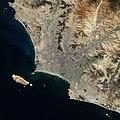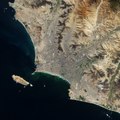File:Lima, Peru ESA23394892.jpeg

Original file (5,400 × 5,400 pixels, file size: 6.88 MB, MIME type: image/jpeg)
Captions
Captions
Summary
edit| DescriptionLima, Peru ESA23394892.jpeg |
English: Lima, the capital and largest city of Peru, is featured in this Copernicus Sentinel-2 image. Zoom in to see this image at its full 10 m resolution or click on the circles to learn more about the features in it. The commercial and industrial centre of Peru, Lima is located on the mostly flat terrain in the Peruvian coastal plain, within the valleys of the Chillón, Rímac and Lurín rivers. The city is bordered on the east by the foothills of the Andes Mountains and on the west by the Pacific Ocean. Lima can be seen directly on the south bank of the Rímac River, which flows for around 200 km through the Lima Region, before emptying near Callao – a seaside city and port in the Lima metropolitan area (the largest metropolitan area of Peru). Lima’s historical centre was declared a UNESCO World Heritage Site in 1988 owing to its large number of historical buildings dating from the Spanish colonial era. One of the most notable characteristics of Lima is the barren desert that surrounds the city, with the sand supporting little to no plant life, with the exception of where water has been artificially provided. Although Lima is located at a tropical latitude, the cool offshore Humboldt Current (also known as the Peru Current) produces a year-round temperate climate. The cooling of the coastal air mass produces thick cloud cover throughout winter and the dense sea mist, known locally as garúa, often rolls in to blanket the city. In this image, captured on 20 April 2020, several cloud formations can be seen dotted along the coast. Callao is Peru’s main seaport and home to its main airport, Jorge Chávez International Airport. Several small boats and vessels can be seen near the port. Callao has several islands: San Lorenzo Island (currently used as a military base), El Frontón (a former high security prison), the Cavinzas Islands, and the Palomino Islands, where numerous sea lions and sea birds live. The Copernicus Sentinel-2 mission consists of a pair of twin satellites that orbit Earth once every 100 minutes, together imaging a path on Earth’s surface 580 kilometres wide. The satellites observe in 13 spectral bands – from visible to infrared light – giving various perspectives on land and vegetation. This means that the mission can be used to retrieve a wealth of different information about Earth’s surface. This image is also featured on the Earth from Space video programme. |
| Date | 16 July 2021 (upload date) |
| Source | Lima, Peru |
| Author | European Space Agency |
| Other versions |
|
| Activity InfoField | Observing the Earth |
| Mission InfoField | Sentinel-2 |
| Set InfoField | Earth observation image of the week |
| System InfoField | Copernicus |
Licensing
edit
|
This image contains data from a satellite in the Copernicus Programme, such as Sentinel-1, Sentinel-2 or Sentinel-3. Attribution is required when using this image.
Attribution: Contains modified Copernicus Sentinel data 2020
Attribution
The use of Copernicus Sentinel Data is regulated under EU law (Commission Delegated Regulation (EU) No 1159/2013 and Regulation (EU) No 377/2014). Relevant excerpts:
Free access shall be given to GMES dedicated data [...] made available through GMES dissemination platforms [...].
Access to GMES dedicated data [...] shall be given for the purpose of the following use in so far as it is lawful:
GMES dedicated data [...] may be used worldwide without limitations in time.
GMES dedicated data and GMES service information are provided to users without any express or implied warranty, including as regards quality and suitability for any purpose. |
Attribution
This media was created by the European Space Agency (ESA).
Where expressly so stated, images or videos are covered by the Creative Commons Attribution-ShareAlike 3.0 IGO (CC BY-SA 3.0 IGO) licence, ESA being an Intergovernmental Organisation (IGO), as defined by the CC BY-SA 3.0 IGO licence. The user is allowed under the terms and conditions of the CC BY-SA 3.0 IGO license to Reproduce, Distribute and Publicly Perform the ESA images and videos released under CC BY-SA 3.0 IGO licence and the Adaptations thereof, without further explicit permission being necessary, for as long as the user complies with the conditions and restrictions set forth in the CC BY-SA 3.0 IGO licence, these including that:
See the ESA Creative Commons copyright notice for complete information, and this article for additional details.
|
 | |
This file is licensed under the Creative Commons Attribution-ShareAlike 3.0 IGO license. Attribution: ESA, CC BY-SA IGO 3.0
| ||
File history
Click on a date/time to view the file as it appeared at that time.
| Date/Time | Thumbnail | Dimensions | User | Comment | |
|---|---|---|---|---|---|
| current | 22:14, 16 July 2021 |  | 5,400 × 5,400 (6.88 MB) | Don-vip (talk | contribs) | Full resolution from TIFF version |
| 09:19, 16 July 2021 |  | 2,970 × 2,970 (1.79 MB) | OptimusPrimeBot (talk | contribs) | #Spacemedia - Upload of https://www.esa.int/var/esa/storage/images/esa_multimedia/images/2021/07/lima_peru/23394881-1-eng-GB/Lima_Peru.jpg via Commons:Spacemedia |
You cannot overwrite this file.
File usage on Commons
The following page uses this file:


